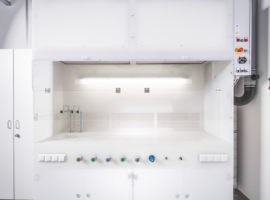
Product Info
Compact, sandwich or GMP modules, recirculation modules (Airboy)
Description
A filter fan unit or FFU or FVE (filter fan unit) is a module consisting of a fan and a filter that draws in air from above and blows it into the room through the filter. The aim is to permanently filter the recirculated air. On the outlet side, the air flow can be either turbulent or laminar.
In the laminar variant, the air flows are parallelized by air baffles. This creates a vertical air flow from the FFU to the floor of the room. Filter fan units are mainly used in ceiling systems of clean and ultra-clean rooms, such as those found in semiconductor production, the microsystems industry, the pharmaceutical and food industries.
In cleanroom technology, mixing ventilation refers to systems that blow HEPA-filtered air into a defined space (usually turbulent) and thus achieve a purification of the room air (colloquially - air dilution). The more turbulent the air is blown in (e.g. with swirl diffusers), the better the clean air mixes with the polluted air. In addition, the contaminated room air is extracted from the room as far away as possible from the point where the clean air is blown in, or close to the source of contamination.
The air exchange rate is the ratio of the amount of air supplied [m³/h] to the room volume [m³]. It provides information on how often (theoretically) the air in the room is exchanged per hour. Typical air exchange rates are between 5 and 20.
Cleanrooms are usually operated under positive pressure by introducing slightly more clean supply air than mixed air is extracted in order to prevent contamination from adjacent rooms. Typical mixed air systems for installation in ceilings can be ceiling diffusers for suspended particles, but also filter fan units with swirl diffusers, baffle plates or perforated plates.
For very high rooms (also for smaller areas within large rooms), airborne particle wall diffusers, displacement air diffusers or floor-mounted recirculation modules (Airboy) are often used. These have the advantage that they discharge the clean air to where it is needed, e.g. at working height, and therefore often manage with a lower air volume than ceiling systems. With such systems, a clean room class up to ISO 6 or class C according to GMP is possible.

























